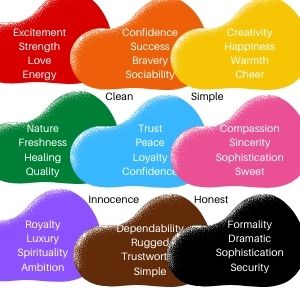
Seeing a beautiful stall will often get us to stop in our tracks to take a look. A well organised and clearly defined stall will allow our brains to easily assimilate what is being seen, and allow us to process the incoming messages faster.
Designing your first market stall to reflect your business and brand message will take some thought. We will look at ways to do this that will encourage a response from passers-by and potential customers. The goal is to create a clear message that will attract your ideal customer. This guide will borrow from the world of psychology and allow you to do this yourself, without the need for a marketing agency.
Before working on your shop-front (market stall) display, make sure you can clearly define your brand. If you currently just plonk your items for sale on your table and ‘wait for them to come‘ then you could be missing a trick. If you don’t have any means of identification by means of a banner or business cards, customers won’t know who they bought their product from, so won’t be able to recommend you to others.
Not having a defined brand means that you don’t particularly build brand loyalty other than ‘oh I sometimes buy honey from the honey stall at the market’. Having a clear business name/brand will allow folk to follow you, be loyal to you and only buy from you. Customers like being loyal to a brand but if you don’t have one, it will be difficult for them. That said…
Define Your Business
- What is your business about? – we sell a superior-tasting sauce
- How is your business different? – we only make vegan , ethically sourced products
- What do you want to be known for? – we are a family run business that sell the best sauce in England!
- What 3 words would describe your business? – family, ethical, delicious
Who is Your Customer?
- Define your ideal customer – folk who appreciate a quality food product
- Now imagine what your customer looks like? – young, family, colourful, political
When you know what your customer looks like, you can use this information to support the creation of your own branding. It will help to really connect with the customers that you want to attract.
Start on Your Branding
Think about the colours that reflect your brand. Learn about colour psychology and how colours can impact your message. Once you have created your logo, which is a symbol that represents your brand and personality, identify the fonts that you will consistently use. Ideally, two that work well together, one for headings and the other for sub-text.
Create your (consistent) social media page headers and most importantly, your customer-facing street banners.

Your brand is your reputation and how you’ll be perceived as a business.

Your brand isn’t what you say it is,
It’s what they [your customers] say it is.
Marty Neumeier
Stall Design
Now that you have laid the groundwork for your brand identity, you can start to work on your stall design. Remember that you are paying for the whole space, so use it wisely. Think of the vegetable sellers – they fill every square inch of their display with stock. Even though you won’t want to overcrowd your table or area, you should have an adequate area to fill with your wares.

Consider this:
- Reflect your brand message and business colours. Do this with your business sign and accessories.
- Your tablecloths will be the largest block of colour so that is an important consideration in your design.
- Think layers – with structures that will allow you to raise up your products.
- See if you can use any space for hanging stock.
- You may have the benefit of being on a corner – use these as ‘end caps’, which are an added window for stock.
- People buy from people, so make sure the seller (you?) is not hidden behind your display and is easily seen.
Retailer Display Secrets
Rule of Three
Remember the rule of 3. Somehow we find items that are grouped in odd numbers more visually appealing. When items are placed in even piles, it seems normal to us and we take no particular notice. However, when items are grouped in odd numbers, our brains register that this is asymmetrical and unbalanced which makes us pause for longer while we assimilate this.
Stack Together
By bundling similar types of products together you can offer multi-buys with the goal of naturally encouraging customers to increase their purchase volume. Not only that, it looks good too.
Pyramid Principle
This is where you display your products in a triangular grouping, having the largest in the centre and smaller items around the outside, which seemingly gives a feeling of the products flowing down towards the customer. This ensures that the display is not flat or uninteresting but offers variety in appearance. Many retailers use this technique as it has proven very effective.

Less Is More
Overcrowded stalls are just too much to absorb. Having specific areas of the stall dedicated to a particular group or category of items helps the brain assimilate what is on offer. Too much and there is brain overload and causes stress so the customer is likely to leave without buying.
8 Second Rule
Any signage should be specific. Your customers should be able to absorb its message without any confusion – within 8 seconds! These are great Announcement Boards

Encourage Touch and Feel
A key reason that people buy from physical stores than online is that they can touch and feel products in person. Create displays that encourage people to touch, feel and smell by removing items from packaging to allow this. Once folk touch something they are much more likely to buy.
Price Cards
Price cards and tickets are the most visually appealing when they are evenly spaced from one another. Consistency is an important factor when displaying any signs because when the information is ordered and spaced out, it is much easier for people to process – making their decision-making process easy and stress-free. Always remember to price your items because if they are not priced, many customers just walk away. See here for Price Signs

Retailers ‘Golden Line’ Secret
In retail, there is a golden line that is the most prized shelf position. That is between eye level and down to about 90cm from the ground. The place where it is easiest to see stuff and you can reach it reasonably. On a stall, you can’t control that too much because your tabletop will be the place where most of your stock will sit (around 70cm). So, when you are creating levels and layers for your stock to sit on, have the higher profit stock sitting at the higher levels, with the rest cascading down in order of price.
Co-ordinate Colours
Putting similar coloured items together always looks appealing and help the products stand out.
Lighting
Clever use of lighting always helps to create ambiance but can help focus on certain products as well as offer more clarity for customers. These are great Clip-on Lights – perfect for a market stall.
Point of Purchase
If you organise your stall where you will have a particular spot that people will pay you (e.g. a till), consider having a few extra add-on items near it, that may remind customers that they need that too and promote extra sales.

Stall Layout
Creating a look and a feel that reflects your brand is the key to designing your stall layout.
Most stall furniture options are of a table and stall covering. But if you have the option of a variety of table layouts within a gazebo set up, just remember that having your sales point as near to the front of the stall as you can, without them having to ‘step inside your area’, works best.
It is sometimes tempting to want to create a cozy area for customers to enter into, with tables on either side creating a walkway, but the reality of customers feeling comfortable enough to do that is slight. Customers feel safer being on the outside looking in because that is what they are used to on a market.
To Conclude
Using these proven techniques to help create your displays will produce potent stimuli which will send signals to the brain that a particular item is worth taking notice of. Remember, a customer won’t be interested in anything that they can’t understand quickly. Clarity is key. So whatever you can do to reduce the customer’s stress levels and help them to feel more comfortable, will increase their dwell time.
A good display attracts traffic. Period.
Happy Trading!
